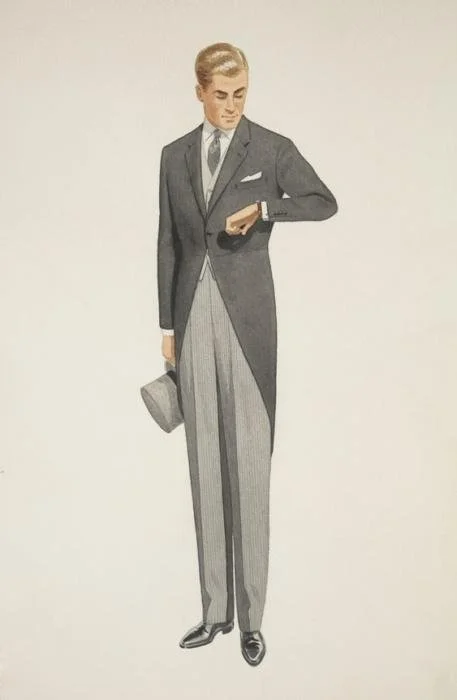Derby
Inspiration
T hese trousers take inspiration from the garments of yesteryear, when a pair of striped trousers was considered an essential part of every gentleman’s wardrobe. They are influenced by formal morning and daytime wear from the early 20th century and more specifically: the traditional morning dress. However, unlike other trousers I have produced previously, this pair features pleats that are left unpressed along the front and back. In other words, giving the trousers a softer, more relaxed drape rather than a rigid fall.
Details and Design Choices
A notable addition compared to earlier projects is the inclusion of a watch pocket, integrated into the waistband seam, which holds the pocket flap in place. The opening is constructed using a method whereby the pocket is first sewn externally and then turned to form the facing. This technique involves stitching the pocket shape in a “U” formation, with the sides equal to the height of the seam allowance, thereby creating the watch pocket opening. A buttonhole is also featured on the watchpocket-flap in order to allow for closing the pocket and avoiding anything leaving the pocket.
Another distinctive element of these trousers is the side adjusters, which adopt a style reminiscent of the Daks button tab system. These, however, are executed using a technique that incorporates the buttonholes into the front waistband itself, rendering them nearly invisible. The side button allows for fastening and adjustment of the waistband in a manner similar to the Daks design. A future improvement on this method that I discovered during this process is the necessity of using canvassing or interfacing along the entire side adjuster. This reinforcement ensures that the buttonholes remain secure and do not loosen or unfasten when using them.
A common issue with cuffed trousers is the accumulation of dust and debris within the cuffs over prolonged wear. Since suiting fabrics require dry cleaning rather than machine washing, I designed the cuffs to be openable. This feature allows for easier cleaning and maintenance, thereby improving the trousers’ lifetime and functionality. To make this feature a hook and eye closure was added on either side of the cuffs, to allow for this practical cleaning of the trouser cuffs.
Fit And Siloutte
The trousers are cut with a more relaxed fit, as the unpressed pleats allow for a natural, fluid drape. The lower section, however, is pressed to maintain the elegant silhouette of a defined cuff and thereby achieving a balance between structure and softness.
Derby represents the first pair, aside from an early prototype, in which I have successfully achieved this particular fit. The waistband conforms beautifully without requiring a belt or suspenders, which was historically an essential aspect of achieving a clean, V-shaped silhouette. Proper fit, especially in traditional tailoring, played a crucial role in defining the overall form and elegance of the wearer.
During the construction of the button fly, the question of where to position the internal fastening button came up. This was resolved by adding an inner button that fastens discreetly to the front pocket, since the front was too small to accomodate the placement of a button without compromising the front pocket size.
Summary And Conclusion
In conclusion, I am very pleased with the outcome of these trousers since they have a professional finish. This project serves as a practice round toward creating a pair of bespoke trousers for a future client that I will be posting about soon. A detailed breakdown of the process, along with additional technical insights, will be available in my upcoming YouTube video, where I discuss the design, construction, and thought process behind this piece.
I’m still in the process of creating a video, so do make sure to turn notifications on so that you don’t miss it or any other future projects: Bygdén Tailoring: YouTube













